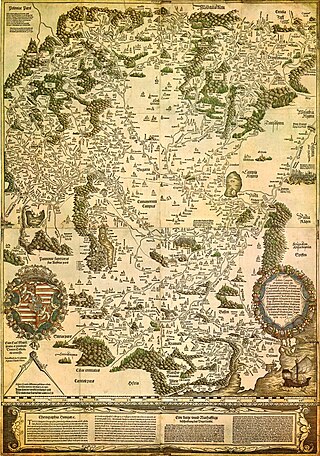
Timiș is a county (județ) of western Romania on the border with Hungary and Serbia, in the historical region of Banat, with the county seat at Timișoara. It is the westernmost and the largest county in Romania in terms of land area. The county is also part of the Danube–Criș–Mureș–Tisa Euroregion.

Vršac is a city in the autonomous province of Vojvodina, Serbia. As of 2022, the city urban area had a population of 31,946, while the city administrative area had 45,462 inhabitants. It is located in the geographical region of Banat.
Several theories, in great extent mutually exclusive, address the issue of the origin of the Romanians. The Romanian language descends from the Vulgar Latin dialects spoken in the Roman provinces north of the "Jireček Line" in Late Antiquity. The theory of Daco-Roman continuity argues that the Romanians are mainly descended from the Daco-Romans, a people developing through the cohabitation of the native Dacians and the Roman colonists in the province of Dacia Traiana north of the river Danube. The competing immigrationist theory states that the Romanians' ethnogenesis commenced in the provinces south of the river with Romanized local populations spreading through mountain refuges, both south to Greece and north through the Carpathian Mountains. Other theories state that the Romanized local populations were present over a wide area on both sides of the Danube and the river itself did not constitute an obstacle to permanent exchanges in both directions; according to the "admigration" theory, migrations from the Balkan Peninsula to the lands north of the Danube contributed to the survival of the Romance-speaking population in these territories.

Grigore Mihail Sturdza, first name also Grigorie or Grigori, last name also Sturza, Stourdza, Sturd̦a, and Stourza, was a Moldavian, later Romanian soldier, politician, and adventurer. He was the son of Prince Mihail Sturdza, a scion of ancient boyardom, and, during the 1840s, an heir apparent to the Moldavian throne, for which he was known throughout his later life as Moldavia's Beizadea. A rebellious youth famous for his feats of strength, he set up his own private militia which he used to corner the Moldavian grain trade, and entered a legal battle with Sardinian retailers. In 1845, he defied his father, and French law, by seeking to marry the much older, already married Countess Dash, and barricaded himself with her at Perieni. By 1847, Grigore had been reintegrated into the Moldavian establishment, and, as a general in the Moldavian princely militia, personally handled repression during the attempted revolution of April 1848. During these events, the Beizadea became personal enemies with three future statesmen—Alexandru Ioan Cuza, Mihail Kogălniceanu, and Manolache Costache Epureanu.
Below is a list of Romanian language exonyms for towns and villages in the Vojvodina region of Serbia.

This article discusses the administrative divisions of the Kingdom of Romania between 1941 and 1944. As a result of the Soviet occupation of Bessarabia and Northern Bukovina, Second Vienna Award and the Treaty of Craiova, territories that had previously been part of Romania were lost to the Soviet Union, Hungary and Bulgaria respectively. By September 1940 the administrative system set up in 1938 based on 'ținuturi' (regions) was disbanded and the former counties (județe) were reintroduced.
An exonym is a place name, used by non-natives of that place, that differs from the official or native name for that place. Turkish has a wealth of exonyms in areas beyond the current borders of Turkey notably those that were once part of Ottoman Empire and its vassals and tributaries or within the Turkish, Ottoman, or a Turkic sphere of cultural or economic influence. In addition, Turkish sometimes renders the names of other cities in a phonetic Turkish spelling, e.g., Chicago as Şikago or Manchester as Mançester. As these forms are not commonly used in Turkish, there is not a systematic attempt to include them here.

The Hungarian conquest of the Carpathian Basin, also known as the Hungarian conquest or the Hungarian land-taking, was a series of historical events ending with the settlement of the Hungarians in Central Europe in the late 9th and early 10th century. Before the arrival of the Hungarians, three early medieval powers, the First Bulgarian Empire, East Francia, and Moravia, had fought each other for control of the Carpathian Basin. They occasionally hired Hungarian horsemen as soldiers. Therefore, the Hungarians who dwelt on the Pontic steppes east of the Carpathian Mountains were familiar with what would become their homeland when their conquest started.
This is a list of Romanian exonyms for cities, towns and villages located in Ukraine.
This page is based on this
Wikipedia article Text is available under the
CC BY-SA 4.0 license; additional terms may apply.
Images, videos and audio are available under their respective licenses.




